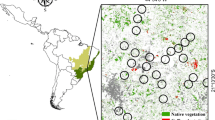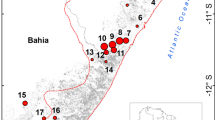Abstract
Theoretical considerations suggest that the ability to detect the presence or approach of a predator when there is still enough time to flee (early detection) should improve with group size, if group living is to be advantageous for individual non-human primates. The hypothesis that the distance at which forest primates detect predators increases with the size of their party was confirmed by observation. It was found that in addition to party size height (vegetation density) could also influence detection distance. Because height relates not only to visibility but also to the number of potential predators, one would predict that small parties are found higher in the canopy to compensate for the increased risk of predation. This prediction was confirmed using data on long-tailed macaques (Macaca fascicularis).
The correlation found between party size and predation risk demonstrates that forest monkeys can adjust their behaviour in response to changes in predation risk, and hence support the hypothesis that predation risk has been an important, perhaps even the only, selective force responsible for the evolution of group living in non-human primates.
Similar content being viewed by others
References
Alexander, R. D., 1974. The evolution of social behavior.Ann. Rev. Ecol. Syst., 5: 325–383.
Altmann, S. A. &J. Altmann, 1970.Baboon Ecology. Chicago Univ. Press, Chicago.
Bartles, M., 1929. Iets over het voedsel van de panter.De Tropische Natuur, 18: 81–83.
Bertram, B. C. R., 1978. Living in groups: predators and prey. In:Behavioural Ecology,J. R. Krebs &N. B. Davies (eds.), Blackwell, Oxford, pp. 64–96.
Clutton-Brock, T. H. &P. H. Harvey, 1977. Primate ecology and social organization.J. Zool. (London), 183: 1–39.
Hamilton, W. D., 1971. Geometry and the selfish herd.J. Theor. Biol., 31: 295–311.
Hoogland, J. L., 1981. The evolution of coloniality in white-tailed and black-tailed prairie dogs (Sciuridae:Cynomys leucurus andC. ludovicianus).Ecology, 62: 252–272.
———— &P. W. Sherman, 1976. Advantages and disadvantages of bank swallow (Riparia riparia) coloniality.Ecol. Monogr., 46: 33–58.
Jorde, L. B. &J. N. Spuhler, 1974. A statistical analysis of selected aspects of primate demography, ecology and social behaviour,J. Anthropol. Res., 30: 199–224.
Marler, P., 1955. Characteristics of some animal calls.Nature, 176: 6–8.
Pulliam, H. R., 1973. On the advantages of flocking.J. Theor. Biol., 38: 419–422.
Raemaekers, J. J. &D. J. Chivers, 1980. Socio-ecology of forest primates. In:Malayan Forest Primates,D. J. Chivers (ed.), Plenum Press, New York, pp. 279–316.
Rijksen, H. D., 1978.A Field Study on Sumatran Orang Utans (Pongo pygmaeus abelliLesson 1827):Ecology, Behaviour and Conservation. Veenman, Wageningen.
Rowell, T. E. &S. M. Richards, 1979. Reproductive strategies of some African monkeys.J. Mammal., 60: 58–69.
Schaik, C. P. van, M. A. van Noordwijk, R. J. de Boer & I. den Tonkelaar, in press. The effect of group size on time budgets and social behaviour in wild long-tailed macaques (Macaca fascicularis).Behav. Ecol. Sociobiol.
Schaller, G. B., 1967.The Deer and the Tiger. Chicago Univ. Press, Chicago.
Siegel, S., 1956.Nonparametric Statistics for the Behavioral Sciences. McGraw-Hill, New York.
Sokal, R. R. &F. J. Rohlf, 1969.Biometry. Freeman, San Francisco.
Treisman, M., 1975. Predation and the evolution of gregariousness. I. Models for concealment and evasion.Anim. Behav., 23: 779–800.
Vine, I., 1971. Risk of visual detection and pursuit by a predator and the selective advantage of flocking behaviour.J. Theor. Biol., 30: 405–422.
Waser, P. M., 1977. Feeding, ranging and group size in the mangabey,Cercocebus albigena. In:Primate Ecology,T. H. Clutton-Brock (ed.), Academic Press, London, pp. 183–222.
Whitten, A. J., 1980. The kloss gibbon in Siberut rain forest. Ph.D. thesis, Univ. of Cambridge.
Wrangham, R. W., 1980. An ecological model of female-bonded primate groups.Behaviour, 75: 262–300.
Author information
Authors and Affiliations
About this article
Cite this article
van Schaik, C.P., van Noordwijk, M.A., Warsono, B. et al. Party size and early detection of predators in sumatran forest primates. Primates 24, 211–221 (1983). https://doi.org/10.1007/BF02381083
Received:
Accepted:
Issue Date:
DOI: https://doi.org/10.1007/BF02381083




